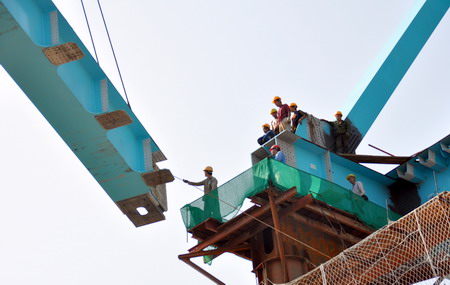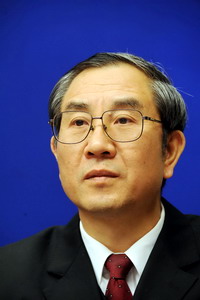Economy
High-speed railway to boost trade
By Bao Chang, Huo Yan, and Huang Zhaohua (China Daily)
Updated: 2011-01-18 13:56
 |
Large Medium Small |
|
 |
|
Construction workers build a bridge for the Nan-Qin Railway in the Guangxi Zhuang autonomous region. Guangxi plans to invest 300 billion yuan ($45 billion) on infrastructure, including a high-speed railway to Southeast Asia. [Photo / China Daily] |
NANNING - The Guangxi Zhuang autonomous region plans to increase its efforts to build a high-speed railway network providing another link with the 10-member Association of Southeast Asian Nations (ASEAN), which is the region's biggest trading partner and export market, over the next five years.
Guangxi is China's main foreign-trade center.
"One of our main tasks during the 12th Five-Year Plan (2011-2015) is to accelerate the construction of a high-speed railway from Nanning to ASEAN countries such as Singapore to establish an international passage, bolstering Guangxi's foreign trade," Ma Biao, chairman of the regional government, said on Monday.
|
 |
|
Ma Biao, chairman of the Guangxi Zhuang autonomous region |
According to the regional government's development and reform commission, the construction of the railway between Nanning and Pingxiang, a city near China's border with Vietnam, will start in the second half of this year.
"We will invest 15.6 billion yuan ($2.36 billion) to build the railway linking Nanning and Singapore via Vietnam, which is extremely important for the construction of the Nanning-Singapore Economic Corridor," Long Li, director at the transportation department of the region's DRC, told China Daily.
The Nanning-Singapore Economic Corridor, the cross-border economic channel between China and the ASEAN, starts at Nanning and encompasses Hanoi in Vietnam, Vientiane in Laos, Phnom Penh in Cambodia, Bangkok in Thailand, Kuala Lumpur in Malaysia, and Singapore.
Ma said the Nanning-Singapore Economic Corridor and bonded port areas round the gulf would become new hotspots and growth points within the China-ASEAN Free Trade Area (CAFTA).
Fueled by the founding of CAFTA, the export and import volumes of Guangxi hit a record $17.71 billion in 2010, with a year-on-year growth rate of 24.3 percent.
ASEAN is the largest trading partner of, and export market for, Guangxi. The bilateral trade volume was $6.53 billion, a rise of 31.9 percent year-on-year, and accounted for 37 percent of the region's total trade volume.
"Guangxi will continue to strengthen its economic cooperation, including the Nanning-Singapore Economic Corridor and the Pan-Beibu Gulf Economic Zone, with neighboring countries," Ma said.
Founded in 2006, the Pan-Beibu Gulf (PBG) Economic Cooperation Zone comprises the Guangxi Zhuang autonomous region, Guangdong and Hainan provinces, Vietnam, Malaysia, Singapore, Indonesia, the Philippines and Brunei.
The PBG cooperation zone is a new sub-regional scheme in the China-ASEAN framework.
"To beef up trade with neighboring countries and provide convenience for commercial interaction, we will spend 300 billion yuan on the construction of the railway within the next five years," Ma said earlier.
Construction of a railway linking Vientiane, the capital of Laos, with the Laos-China border, may begin in 2012 with China's help, as part of a proposed high-speed rail network linking China and Singapore via Laos, Thailand and Malaysia.
| 分享按鈕 |